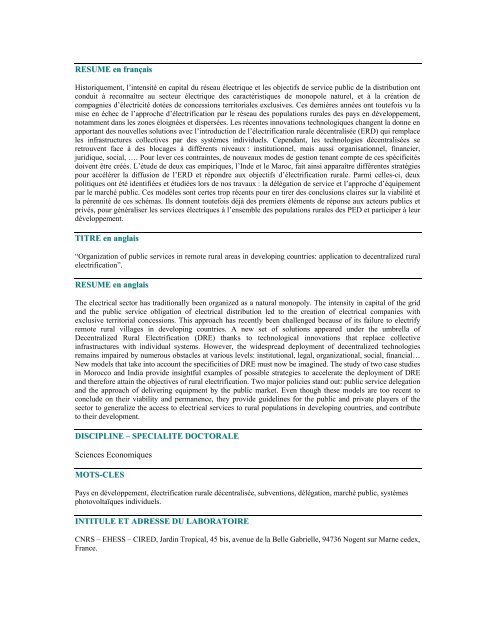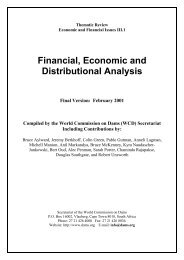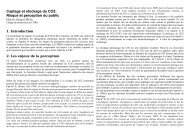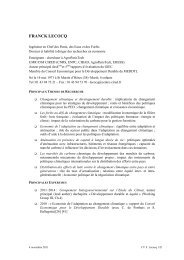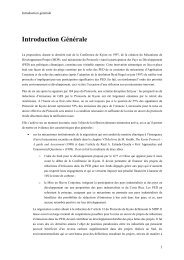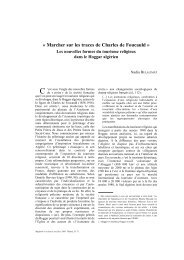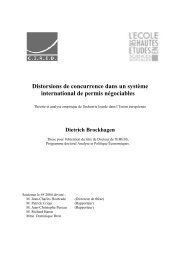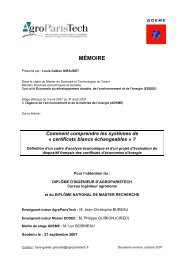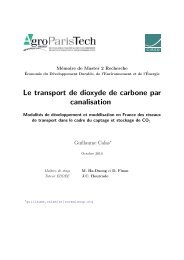Les modes organisationnels des services publics en milieu rural ...
Les modes organisationnels des services publics en milieu rural ...
Les modes organisationnels des services publics en milieu rural ...
Create successful ePaper yourself
Turn your PDF publications into a flip-book with our unique Google optimized e-Paper software.
RESUME <strong>en</strong> françaisHistoriquem<strong>en</strong>t, l’int<strong>en</strong>sité <strong>en</strong> capital du réseau électrique et les objectifs de service public de la distribution ontconduit à reconnaître au secteur électrique <strong>des</strong> caractéristiques de monopole naturel, et à la création decompagnies d’électricité dotées de concessions territoriales exclusives. Ces dernières années ont toutefois vu lamise <strong>en</strong> échec de l’approche d’électrification par le réseau <strong>des</strong> populations <strong>rural</strong>es <strong>des</strong> pays <strong>en</strong> développem<strong>en</strong>t,notamm<strong>en</strong>t dans les zones éloignées et dispersées. <strong>Les</strong> réc<strong>en</strong>tes innovations technologiques chang<strong>en</strong>t la donne <strong>en</strong>apportant <strong>des</strong> nouvelles solutions avec l’introduction de l’électrification <strong>rural</strong>e déc<strong>en</strong>tralisée (ERD) qui remplaceles infrastructures collectives par <strong>des</strong> systèmes individuels. Cep<strong>en</strong>dant, les technologies déc<strong>en</strong>tralisées seretrouv<strong>en</strong>t face à <strong>des</strong> blocages à différ<strong>en</strong>ts niveaux : institutionnel, mais aussi organisationnel, financier,juridique, social, …. Pour lever ces contraintes, de nouveaux <strong>mo<strong>des</strong></strong> de gestion t<strong>en</strong>ant compte de ces spécificitésdoiv<strong>en</strong>t être créés. L’étude de deux cas empiriques, l’Inde et le Maroc, fait ainsi apparaître différ<strong>en</strong>tes stratégiespour accélérer la diffusion de l’ERD et répondre aux objectifs d’électrification <strong>rural</strong>e. Parmi celles-ci, deuxpolitiques ont été id<strong>en</strong>tifiées et étudiées lors de nos travaux : la délégation de service et l’approche d’équipem<strong>en</strong>tpar le marché public. Ces modèles sont certes trop réc<strong>en</strong>ts pour <strong>en</strong> tirer <strong>des</strong> conclusions claires sur la viabilité etla pér<strong>en</strong>nité de ces schémas. Ils donn<strong>en</strong>t toutefois déjà <strong>des</strong> premiers élém<strong>en</strong>ts de réponse aux acteurs <strong>publics</strong> etprivés, pour généraliser les <strong>services</strong> électriques à l’<strong>en</strong>semble <strong>des</strong> populations <strong>rural</strong>es <strong>des</strong> PED et participer à leurdéveloppem<strong>en</strong>t.TITRE <strong>en</strong> anglais“Organization of public <strong>services</strong> in remote <strong>rural</strong> areas in developing countries: application to dec<strong>en</strong>tralized <strong>rural</strong>electrification”.RESUME <strong>en</strong> anglaisThe electrical sector has traditionally be<strong>en</strong> organized as a natural monopoly. The int<strong>en</strong>sity in capital of the gridand the public service obligation of electrical distribution led to the creation of electrical companies withexclusive territorial concessions. This approach has rec<strong>en</strong>tly be<strong>en</strong> chall<strong>en</strong>ged because of its failure to electrifyremote <strong>rural</strong> villages in developing countries. A new set of solutions appeared under the umbrella ofDec<strong>en</strong>tralized Rural Electrification (DRE) thanks to technological innovations that replace collectiveinfrastructures with individual systems. However, the wi<strong>des</strong>pread deploym<strong>en</strong>t of dec<strong>en</strong>tralized technologiesremains impaired by numerous obstacles at various levels: institutional, legal, organizational, social, financial…New models that take into account the specificities of DRE must now be imagined. The study of two case studiesin Morocco and India provide insightful examples of possible strategies to accelerate the deploym<strong>en</strong>t of DREand therefore attain the objectives of <strong>rural</strong> electrification. Two major policies stand out: public service delegationand the approach of delivering equipm<strong>en</strong>t by the public market. Ev<strong>en</strong> though these models are too rec<strong>en</strong>t toconclude on their viability and perman<strong>en</strong>ce, they provide guidelines for the public and private players of thesector to g<strong>en</strong>eralize the access to electrical <strong>services</strong> to <strong>rural</strong> populations in developing countries, and contributeto their developm<strong>en</strong>t.DISCIPLINE – SPECIALITE DOCTORALESci<strong>en</strong>ces EconomiquesMOTS-CLESPays <strong>en</strong> développem<strong>en</strong>t, électrification <strong>rural</strong>e déc<strong>en</strong>tralisée, subv<strong>en</strong>tions, délégation, marché public, systèmesphotovoltaïques individuels.INTITULE ET ADRESSE DU LABORATOIRECNRS – EHESS – CIRED, Jardin Tropical, 45 bis, av<strong>en</strong>ue de la Belle Gabrielle, 94736 Nog<strong>en</strong>t sur Marne cedex,France.


